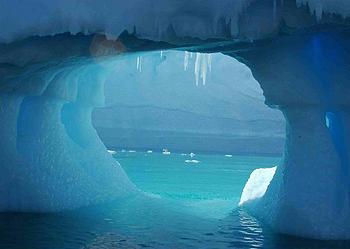
CORVALLIS, Oregon, July 15, 2013 (ENS) – Global sea levels will rise about 2.3 meters, or 7.5 feet, for every degree Celsius (1.8 degrees Fahrenheit) that the planet warms over the next several thousand years, finds new research that combines all the major causes of sea level rise.
This international study is one of the first to combine analyses of the four major contributors to potential sea level rise into a collective estimate, and compare it with evidence of past sea-level responses to global temperature changes.

Scientists say the four major contributors to sea-level rise on a global scale are: melting of glaciers, melting of the Greenland ice sheet, melting of the Antarctic ice sheet, and expansion of the ocean itself as it warms.
Several past studies have examined each of these components, the authors of this study say, but this is an early attempt to merge the four different analyses into a single projection.
The study, funded by the U.S. National Science Foundation and the German Federal Ministry of Education and Research, is published in the current issue of the journal “Proceedings of the National Academy of Sciences.”
“The study did not seek to estimate how much the planet will warm, or how rapidly sea levels will rise,” said author Peter Clark, an Oregon State University paleoclimatologist.
“Instead, we were trying to pin down the sea-level commitment of global warming on a multi-millennial time scale. In other words, how much would sea levels rise over long periods of time for each degree the planet warms and holds that warmth?”

“The simulations of future scenarios we ran from physical models were fairly consistent with evidence of sea-level rise from the past,” Clark explained.
“Some 120,000 years ago,” he said, “it was one to two degrees warmer than it is now and sea levels were about five to nine meters higher. This is consistent with what our models say may happen in the future.”
The researchers ran hundreds of simulations through their computer models to calculate how the four components would respond to warming, Clark said, finding that the amount of melting and subsequent sea-level response was commensurate with the amount of warming.
The exception, Clark said, is Greenland, which seems to have a threshold at which the response can be amplified.
“As the ice sheet in Greenland melts over thousands of years and becomes lower, the temperature will increase because of the elevation loss,” Clark said. “For every 1,000 meters of elevation loss, it warms about six degrees Celsius. That elevation loss would accelerate the melting of the Greenland ice sheet.”
By contrast, the Antarctic ice sheet is so cold that elevation loss will not affect it the same way.

The melting of the ice sheet there comes primarily from the calving of icebergs, which float away and melt in warmer ocean waters, or the contact between the edges of the ice sheet and seawater.
The authors note that sea-level rise in the past century has been dominated by the expansion of the ocean and melting of glaciers.
In the future, the biggest contributions may come from melting of the Greenland ice sheet, which could disappear entirely, and the Antarctic ice sheet, which will likely reach some kind of equilibrium with atmospheric temperatures and shrink significantly, but not disappear, the authors predict.
“Keep in mind that the sea level rise projected by these models of 2.3 meters per degree of warming is over thousands of years,” said Clark, who is a professor in Oregon State University’s College of Earth, Ocean, and Atmospheric Sciences, where he teaches history and dynamics of former glaciers and ice sheets, paleo-sea level, paleoclimatology and abrupt climate change.
“If it warms a degree in the next two years, sea levels won’t necessarily rise immediately,” said Clark. “The Earth has to warm and hold that increased temperature over time.”
“However, carbon dioxide has a very long time scale and the amounts we’ve emitted into the atmosphere will stay up there for thousands of years,” he warned. “Even if we were to reduce emissions, the sea-level commitment of global warming will be significant.”
Copyright Environment News Service (ENS) 2013. All rights reserved.
© 2013, Environment News Service. All rights reserved. Content may be quoted only with proper attribution and a direct link to the original article. Full reproduction is prohibited.
